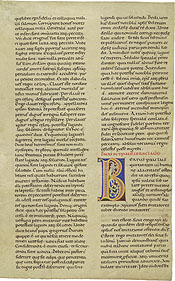
11th Century
![]()
This script demonstrates the evolution of Caroline minuscule in the direction
of the Gothic form that was to dominate bookhands during the High Middle
Ages (13th-16th centuries); thus it is sometimes called "Protogothic."
In this transition, scribes began to separate words more clearly, replaced
the ae-diphthong with the æ-ligature or the letter
e with a cedilla (which stood for the letter a), kept
the foot of the tall letter s on rather than below the line,
wrote the letter d with a stem curved to the left rather than
a vertical stem, and made more use of abbreviations.
Purchased in 1888 for A. D. White.
![]()
Homiletic Miscellany, Fragment. Italy, late 11th or early 12th
century.
![]()

Copyright
© 2002 Division of Rare & Manuscript
Collections
2B Carl A. Kroch Library, Cornell University, Ithaca, NY, 14853
Phone Number: (607) 255-3530. Fax Number: (607) 255-9524
For
reference questions, send mail to:
rareref@cornell.edu
If you have questions or comments about the site, send mail to: webmaster.